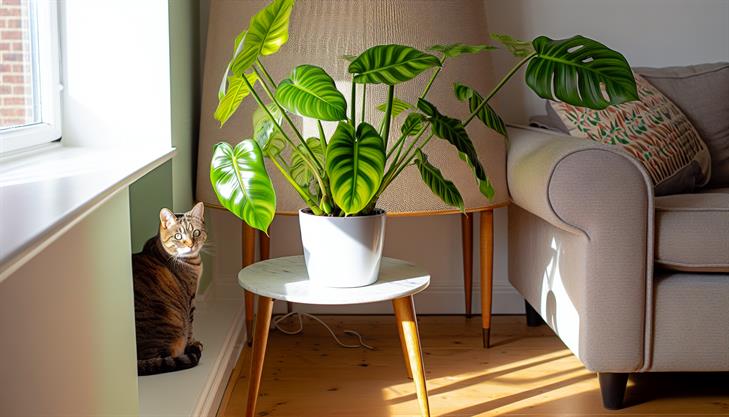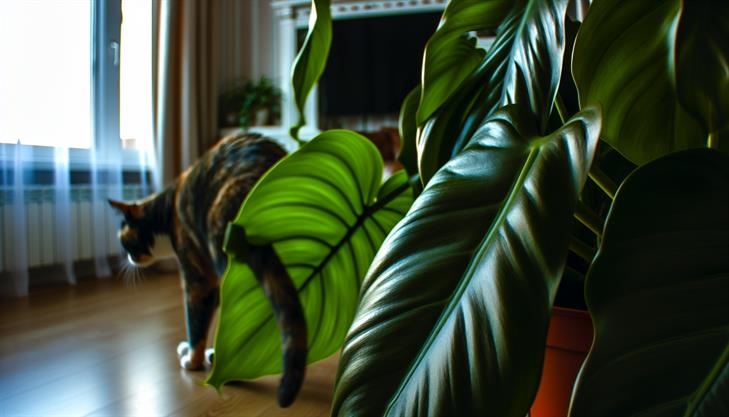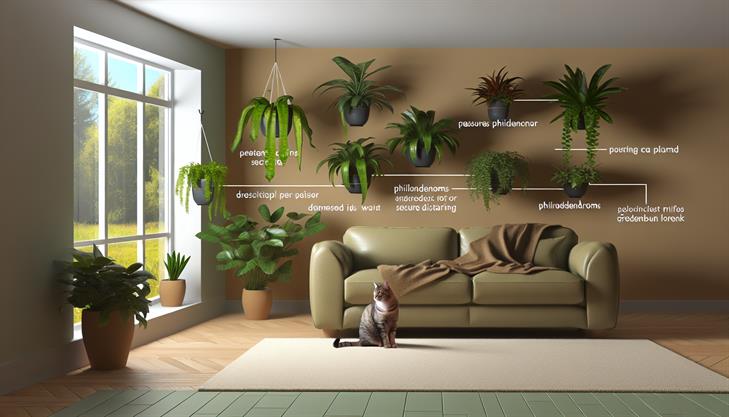In the lush world of houseplants, philodendrons stand out with their vibrant, heart-shaped leaves and graceful vining tendencies. They effortlessly breathe life into our homes, but alongside their beauty lies a question that many pet owners are too familiar with: Are philodendrons toxic to cats? As our feline friends meander curiously through our living spaces, the risk of accidental ingestion becomes a genuine concern. This blog post dives into the crucial intersection of plant aesthetics and pet safety, equipping cat owners with the knowledge they need to keep their curious companions safe. Discover the truth about philodendrons and uncover practical insights to ensure your home remains a sanctuary for both your plants and your pets. Read on to find out how you can enjoy the best of both worlds with peace of mind.
Understanding Philodendrons: Popular Houseplants
Philodendrons are beloved houseplants known for their attractive foliage and ease of care. However, if you are a pet owner, particularly of cats, it is crucial to be aware that philodendrons are indeed toxic to cats. Understanding the associated risks and taking appropriate measures can help you maintain a pet-friendly home without giving up these beautiful plants.
Why Philodendrons are Toxic to Cats
Philodendrons contain insoluble calcium oxalate crystals, which are toxic when ingested by cats. These needle-like crystals can penetrate the soft tissues of your cat’s mouth, throat, and gastrointestinal tract, leading to a variety of health issues.
Symptoms of Philodendron Poisoning in Cats
If a cat chews on or ingests parts of a philodendron, it may show several symptoms, including:
- Oral irritation
- Excessive drooling
- Pawing at the mouth
- Vomiting
- Difficulty swallowing
In severe cases, your cat might experience respiratory difficulties, which require immediate veterinary attention.
Preventive Measures
To prevent your cat from coming into contact with philodendrons, consider the following advice:
-
Placement: Position philodendrons out of your cat’s reach. High shelves or a hanging basket can be effective, although adventurous cats may still find a way to reach them.
-
Repellant Tactics: Use pet-safe deterrent sprays around the base of the plant. This can discourage your cat from approaching.
-
Alternative Safe Plants: Introduce non-toxic plants to your home that provide similar aesthetic value, like the Spider Plant or Boston Fern, that are harmless if ingested by cats.
-
Supervision: Keep an eye on your cat’s behavior and interactions with houseplants. Remove plants from areas where your cat frequently explores or lounges.
What to Do if Your Cat Ingests Philodendron
If you suspect your cat has ingested philodendron, take these steps:
-
Immediate Care: Rinse your cat’s mouth gently with water to flush out remaining plant material.
-
Contact a Veterinarian: Call or visit a vet promptly with detailed information, such as how much your cat might have ingested and any symptoms it is exhibiting. Timely medical intervention is crucial for a swift recovery.
Additional Advice
-
Educate Yourself: Familiarize yourself with a list of toxic plants, so you can make informed decisions when bringing new plants into your home.
-
Consultation: Before purchasing a houseplant, consult with a garden center expert about its safety around pets.
-
Pet Behavior Training: Help train your cat to avoid houseplants by using positive reinforcement techniques. Reward your cat when it stays away from plants.
With careful management and awareness, pet owners can enjoy the beauty of philodendrons without compromising the health and safety of their feline companions. Always prioritize your pet’s well-being and seek professional advice if you have any concerns about potential plant toxicity.
Why Philodendrons are Toxic to Cats
Philodendrons are popular houseplants admired for their lush foliage and easy care. However, if you’re a cat owner, it’s important to understand that philodendrons can be toxic to cats. Here’s a closer look at why these plants pose a risk and what measures you can take to keep your feline friends safe.
Understanding the Toxicity
Why are Philodendrons Toxic?
Philodendrons contain insoluble calcium oxalates. These are needle-like crystals that can cause irritation and swelling if ingested by cats. The impact can range from mild to severe, depending on the amount consumed.
Symptoms of Philodendron Poisoning in Cats
If your cat chews on or ingests philodendron leaves, you might notice symptoms such as:
- Drooling
- Pawing at the mouth
- Oral irritation
- Vomiting
- Difficulty swallowing
In severe cases, your cat could experience respiratory difficulties or distress. It’s crucial to contact a veterinarian immediately if you suspect your cat has consumed any part of a philodendron.
Prevention Tips
Ensuring a Safe Environment
To prevent your cat from interacting with philodendrons, consider the following strategies:
-
Placement: Keep philodendrons in areas that are inaccessible to cats. High shelves or hanging baskets can keep plants out of reach.
-
Alternatives: Provide your feline with safe plants or cat-friendly grasses to deter their interest in harmful plants.
-
Training: Use training techniques to teach your cat to avoid certain areas or plants. This might include deterrent sprays or gentle corrections.
-
Use Barriers: Consider physical barriers like childproof gates or plant cloches to keep cats away from plants.
What to Do if Your Cat Ingests Philodendron
-
Identify Symptoms: First, observe any signs of distress as mentioned above.
-
Remove Plant Access: Quickly remove your cat from the area where the plant is located to prevent further ingestion.
-
Contact Your Veterinarian: Provide them with details on what was consumed, the approximate amount, and symptoms that are appearing.
-
Follow Professional Advice: Depending on the severity, your vet might suggest bringing your cat in for treatment or managing symptoms at home with close monitoring.
Alternative Cat-Safe Plants
While philodendrons can provide aesthetic appeal, you might want to consider safer options for your home. Some cat-friendly plants include:
- Spider plants
- Boston ferns
- Areca palms
- Christmas cactus
Incorporating these alternatives can keep your spaces green while ensuring that your feline companions remain safe and healthy.
In conclusion, while philodendrons bring a tropical vibe to your indoor spaces, being aware of their risks to pets ensures that your home is both beautiful and safe. By understanding the risks and taking preventative measures, you can enjoy a harmonious home for both plants and your beloved cats.
Symptoms of Philodendron Poisoning in Cats
Philodendrons are popular houseplants known for their lush, green foliage and easy maintenance. However, despite their aesthetic appeal, they pose a significant risk to cats. The question many pet owners ask, "Are philodendrons toxic to cats?" has a clear answer: yes, philodendrons are indeed toxic to cats. This toxicity is primarily due to the presence of calcium oxalate crystals, which can cause severe physical distress in felines.
Symptoms of Philodendron Poisoning in Cats
Understanding the symptoms of philodendron poisoning can help pet owners take quick action if their cat comes into contact with this plant. Here are the key symptoms to watch out for:
-
Oral Irritation: One of the earliest signs is excessive drooling or pawing at the mouth. Cats may exhibit signs of discomfort or pain when attempting to eat or drink.
-
Swelling and Pain: The ingestion of philodendron can lead to swelling in the lips, tongue, and throat, making it difficult for your cat to breathe or swallow.
-
Gastrointestinal Distress: Vomiting and diarrhea are common symptoms as the cat’s body tries to expel the toxic plant material.
-
Difficulty Swallowing: Due to the irritation and swelling, your cat may have trouble swallowing, leading to increased drooling.
-
Decreased Appetite and Lethargy: A cat affected by philodendron poisoning might become less interested in food and display unusual fatigue.
Immediate Actions and Treatment
If you suspect your cat has ingested any part of a philodendron plant, it’s imperative to act quickly. Here’s what you should do:
-
Remove the Plant: Immediately take away the plant to prevent further ingestion.
-
Rinse the Mouth: If possible, gently rinse your cat’s mouth with water to reduce irritation from the plant’s sap. Be careful and gentle to avoid causing additional stress.
-
Seek Veterinary Assistance: Contact your veterinarian promptly. Share details about what part of the plant was ingested and the symptoms you’re observing.
-
Follow Veterinary Advice: Your vet may suggest inducing vomiting or administering activated charcoal, but only do so under professional guidance.
Prevention Tips
Preventing your cat from encountering philodendrons is the best way to avoid toxicity. Here are some strategies:
-
Placement: Keep philodendrons in areas that are inaccessible to your cat. Consider using hanging planters or shelves out of reach.
-
Training: Use cat-repellent sprays or aluminum foil as a deterrent around plant bases.
-
Alternative Plants: Opt for non-toxic houseplants. Research and choose cat-safe plants such as spider plants or Boston ferns.
By understanding the risks and symptoms of philodendron poisoning, pet owners can better protect their feline friends. Awareness and preparation are key to ensuring that your home remains a safe environment for your cat. Always consult with your veterinarian if you have concerns or need guidance regarding pet-safe plants.
How to Keep Your Cat Safe Around Houseplants
Cats are naturally curious creatures, known for their love of exploring every nook and cranny of your home. While this trait is endearing, it can become a challenge when it comes to houseplants. If you’re wondering, "Are philodendrons toxic to cats?" the quick answer is, yes, philodendrons are poisonous to cats. To ensure the safety of your feline friend while enjoying the beauty of these popular houseplants, consider the following guidance:
Understanding Philodendron Toxicity
Philodendrons contain insoluble calcium oxalates, which are needle-like crystals that can penetrate your cat’s tissue upon ingestion. This can lead to irritation and swelling, primarily in the mouth and digestive tract. Common signs that your cat may have chewed on a philodendron include drooling, difficulty swallowing, pawing at the mouth, or vomiting.
Tips to Protect Your Cat from Philodendron Poisoning
-
Placement Matters:
- High and Secure: Keep philodendrons on high shelves or hanging pots where your cat cannot easily access them. Ensure these locations are stable, as cats are known for their jumping prowess.
- Barrier Use: Consider using barriers or plant cages if your cat is exceptionally curious or agile.
-
Training and Deterrence:
- Deterrent Sprays: Use pet-safe deterrent sprays that make the plant’s taste unappealing to your cat.
- Training: Consistently train your cat to avoid houseplants, using positive reinforcement methods. Reward them for ignoring the plant and provide distractions like cat grass or safe chew toys.
-
Safety First: Monitoring and Substitutes:
- Regular Monitoring: Keep an eye on both your philodendrons and your cat’s behavior around them.
- Non-Toxic Alternatives: Consider replacing philodendrons with non-toxic plants like spider plants, Boston ferns, or bamboo palms, which are safe for cats but still provide greenery within your home.
-
Create a Cat-Friendly Environment:
- Dedicated Green Spaces: Set up a space for your cat with safe cat-friendly plants and climbing structures to fulfill their natural instincts without risking their health.
- Plant Replicas: If you enjoy the look of philodendrons but want to eliminate risk, consider high-quality artificial plants that can mimic the real thing without any health hazards.
Immediate Action if Ingested
If you suspect your cat has ingested any part of a philodendron, it is essential to act quickly:
- Vet Consultation: Contact your veterinarian immediately to discuss symptoms and potential treatments.
- Safe Transportation: If advised by your vet, transport your cat safely to the clinic, bringing a part of the plant for identification if necessary.
- First Aid Knowledge: While en route, you may rinse your cat’s mouth with clean water if it is safe to do so, but avoid making your cat vomit unless instructed by a professional.
By implementing these strategies, you can effectively keep your cat safe around philodendrons while adding a lush touch to your home environment. Being informed and proactive is key to ensuring your cat remains happy and healthy while enjoying the indoor greenery.
What to Do if Your Cat Ingests Philodendrons
If you suspect your cat has ingested philodendrons, it’s crucial to take immediate action, as philodendrons are indeed toxic to cats. This popular houseplant contains insoluble calcium oxalates, which can cause discomfort and serious health issues for your furry friend. Here’s what you need to do if you’re faced with this situation:
-
Identify Symptoms of Philodendron Poisoning:
Keep an eye out for symptoms such as oral irritation, excessive drooling, difficulty swallowing, vomiting, and decreased appetite. Cats might also show signs of pawing at their mouth due to irritation. Recognizing these symptoms early can be pivotal in addressing the issue promptly. -
Remove Access to the Plant:
As soon as you notice your cat has ingested any part of a philodendron, immediately remove the plant from their environment to prevent further ingestion. Secure the plant in a location that is inaccessible to your pet. -
Rinse Your Cat’s Mouth:
If possible, gently rinse your cat’s mouth with water to remove any plant residue. Use a soft, damp cloth to wipe the inside of their mouth, taking care not to distress your pet further. -
Contact Your Veterinarian:
Contact your veterinarian or an emergency animal clinic right away for professional advice. Explain the situation in detail, including the amount of philodendron your cat ingested and the symptoms they are displaying. A veterinary professional can provide tailored advice and possibly recommend bringing your cat in for a check-up. -
Follow Veterinary Advice:
Follow any instructions given by your vet meticulously. This might include bringing your cat in for a physical examination or administering specific treatments. The vet may suggest intravenous fluids or medication to control symptoms and prevent complications. -
Monitor Ongoing Symptoms:
Keep a close watch on your cat’s condition. If symptoms persist, worsen, or new ones develop, seek immediate veterinary attention. Continuous monitoring helps ensure your cat recovers fully without any long-term health impacts. -
Prevent Future Incidents:
To prevent future issues, consider relocating philodendrons to an area your cat cannot access, or replace the plant with non-toxic alternatives more suitable for pet-friendly households. Research thoroughly or consult with your vet on safe houseplant options. -
Educate Yourself on Pet-Safe Plants:
Familiarize yourself with other common household plants that may be harmful to pets. Ensuring your home environment is safe for cats will prevent similar situations from occurring in the future.
By taking these steps quickly and effectively, you can help alleviate the risks associated with philodendron toxicity in cats. Proactive measures, such as keeping hazardous plants out of reach and learning about pet-safe plants, can make your home a safer place for all its inhabitants.
In conclusion, while philodendrons are aesthetically pleasing and popular houseplants, it is crucial for cat owners to recognize their potential toxicity to our feline friends. The key takeaway is that philodendrons contain insoluble calcium oxalates, which can cause distressing symptoms such as oral irritation, drooling, and difficulty swallowing if ingested by cats. To ensure our pets’ safety, it is essential to keep these plants out of their reach or consider opting for pet-safe alternatives. As responsible pet owners, being aware of these risks helps us create a safer home environment for our beloved companions.
A practical step could involve creating a pet-friendly zone without toxic houseplants, or using hanging planters to keep such plants away from curious cats. Lastly, always maintain the contact information of your veterinarian or the Animal Poison Control in an easily accessible place for emergencies. By applying these insights and tips, you can enjoy your greenery while ensuring the well-being of your furry family members.


